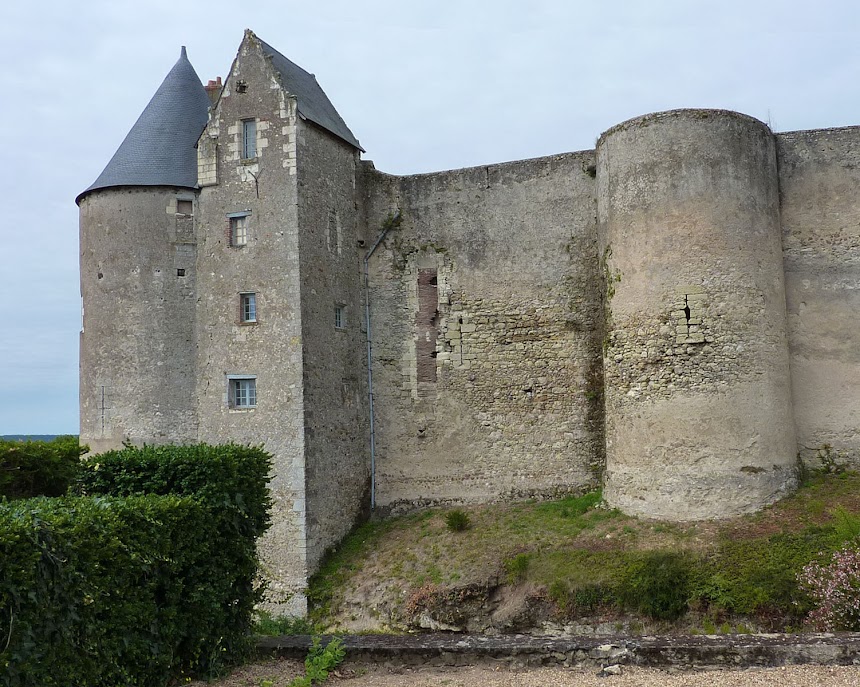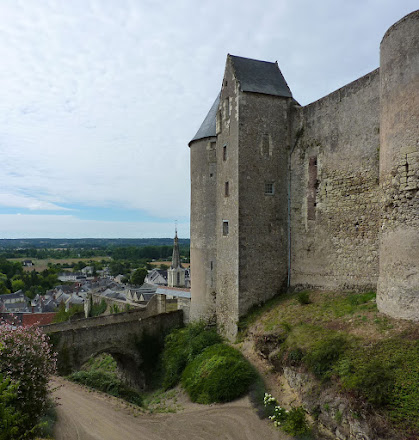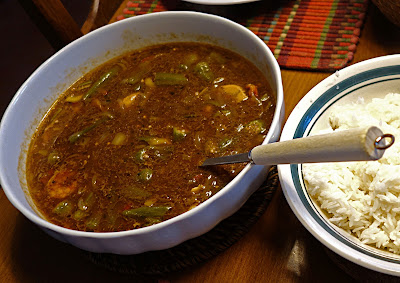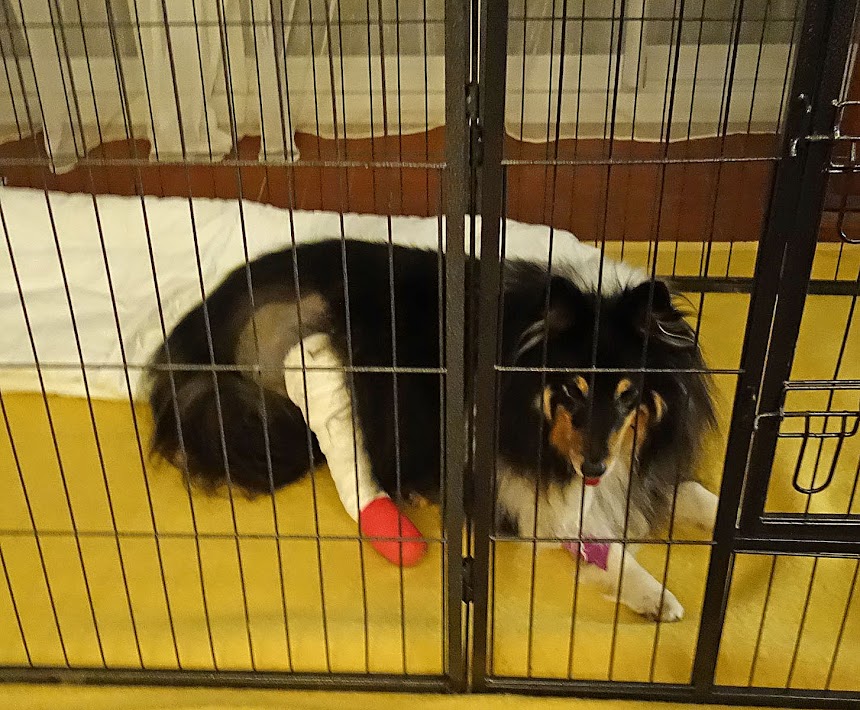Walt and I had been to Ussé 10 years before CHM and I went there in 2010. We were staying in a gîte in Vouvray with our late friend Cheryl. It was our second trip to the the Loire Valley. Cheryl spent a week with us, and CHM spent the second week with us. We did a lot of driving around and saw many sights. Two years later, we were living here. As you can see, the Château d'Ussé is quite an attraction. Fine furnishings. Period costumes. Horse-drawn carriages. A chapel. Wine cellars. French gardens. And Flemish tapestries.
31 January 2022
30 January 2022
Le Château d'Ussé
Here's a composite photo of the Château d'Ussé. It's on the left bank of the Loire river about 20 miles west of Tours and Luynes. I took the two photos that I've stitched together to make a kind of panorama on the same day when CHM and I went to Parçay-Meslay and Luynes. We were just driving by and we stopped for a Kodak (or Panasonic) moment. The Michelin guidebook refers to Ussé as « cette impressionnante masse blanche » and says that when you see it « ...il faut vous pincer bien fort, pour vérifier que vous ne rêvez pas... ». Both Michelin and the Cadogan Loire guidebook says that this is the castle that is said to have inspired the tale of Sleeping Beauty — that's La Belle au bois dormant in French. Cadogan calls Ussé a picture-book château.
29 January 2022
La ferme de Meslay et sa grange
In the little town called Parçay-Meslay [par-say-may-'lay] on the northeast side of Tours there's fortified farm that was built by the monks at the nearby Abbaye de Marmoutier in the 13th century. Marmoutier itself was founded by saint Martin de Tours in the fourth century A.D. The farm covered an area of two hectares (five acres) that was was completely walled in. The roof of the barn on the property was set on fire by English soldiers during the Hundred Years' War and was rebuilt in the 15th century — that roof still exists.
28 January 2022
Luynes : the castle and its courtyard
The Cadogan guidebook for the Loire Valley says of the Château de Luynes that inside its gray medieval exterior it contains a 'surprisingly sophisticated courtyard" — its elegance is such a contrast to "the stern exteriors" of the medieval fortress.



I wish I could take credit for the photo just above, but I can't. I found it on this web site.
(The other four photos in this post are mine.)

 There's a lot more information, with many photos, on the Monumentum page about the Château de Luynes.
There's a lot more information, with many photos, on the Monumentum page about the Château de Luynes.



I wish I could take credit for the photo just above, but I can't. I found it on this web site.
(The other four photos in this post are mine.)

 There's a lot more information, with many photos, on the Monumentum page about the Château de Luynes.
There's a lot more information, with many photos, on the Monumentum page about the Château de Luynes.27 January 2022
Luynes : le duc et le château
Before the town of Luynes was given that name in the 17th century, it was known as Maillé. The founder of the place was a Gallo-Roman figure named Malliacum. By the Middle Ages the name of his descendants and the town had evolved phonetically to become Maillé. Luynes is a village in Provence, and the man who would become the duke of Luynes came from there. He was a childhood friend of the French king Louis XIII, who reigned from 1610 until 1643, with his mother Marie de Médecis as regent early on. King Louis and the duke — he was made a duke and a peer of the realm by Louis in 1619 — were said to be hunting and falconry buddies. Luynes became the king's most powerful minister; his successor would be Richelieu.


The Château de Luynes stands atop a rock spur, with the town below. The imposing towers date back to the 13th century.
Nowadays, the dry moat around the château has been turned into a garden.
 In the 15th cerntury, when the forbidding medieval fortress was still owned by the Maillé family, window openings
In the 15th cerntury, when the forbidding medieval fortress was still owned by the Maillé family, window openingswere cut in the tower walls. Windows brought a lot more light into the austere gray buildings.


The Château de Luynes is still owned and occupied by the descendants of the first duke of Luynes.
It was only opened to the public in the 1990s.
26 January 2022
Luynes : looking up, looking down
This has been a really busy week, what with having to carry the dog up and down stairs several times a day. We also have to watch Tasha closely all day to make sure she doesn't pull her stitches out by licking and biting the incision. She did that a few years ago when we had her spayed. She has figured out how to pull her Elizabethan "cone of shame" off, but she's only done so one time. Better news is that she is starting to put a little weight on the hind leg that was injured. We are still going on short walks two or even three times a day. We have an appointment with the local vet to have her stitches taken out next Monday, so five days to go before we enter the next phase of her recovery.
Meanwhile, here are a few more photos I took in Luynes when CHM and I went there a dozen years ago.
25 January 2022
Back to Luynes
I published two posts about the town of Luynes last week, and then I got distracted by the dog's situation and by some foods I enjoy. One of the photos I took in Luynes, which is only 5 miles from the center of the city of Tours, was this 16th century half-timbered house. Here are a few detail photos I also took the day CHM and I were there in 2010.
24 January 2022
A shrimp and okra weekend


• That first photo might not be very appetizing. Do you know what it is? It's a chocolate- brown roux
in which have been cooked sliced onions, celery, and bell pepper (red, green, and yellow).
• The second photo shows steamer-cooked okra pods that have been cut into pieces so that they can
better release their magical "goo", as the Wikipedia article about okra calls it.


• The meats I put in were turkey breast, pork sausage, and shrimp. I fried the turkey and sausage
before adding them to the thickened broth. The shrimp just cooked in the broth.
• The broth is chicken bouillon into which which I stirred the "roux goo" as a thickener.
The okra goo also has thickening power in the broth.
23 January 2022
Shrimp and grits... and okra
Two products we wanted from the Asia Market grocery store last when we went to Tours the other day were frozen shrimp, a.k.a. prawns and in French crevettes, and either fresh or frozen okra (called gombos in French). We already had a bag of American grits in the pantry. Grits are a ground white corn mush (or porridge) that originated, apparently, in the U.S. South.
In coastal South Carolina, where shrimp and grits was a seasonal dish often served at brealfast, grits used to be called hominy. We used the term "hominy grits" in North Carolina. This porridge made from dried corn kernels is similar to Italian polenta, but with a slightly different texture because of the way the corn is processed and milled. On the internet I see the term gruau de maïs for the same kind of thing in French. (Gruau must be "gruel".)
In coastal South Carolina, where shrimp and grits was a seasonal dish often served at brealfast, grits used to be called hominy. We used the term "hominy grits" in North Carolina. This porridge made from dried corn kernels is similar to Italian polenta, but with a slightly different texture because of the way the corn is processed and milled. On the internet I see the term gruau de maïs for the same kind of thing in French. (Gruau must be "gruel".)
 We don't find okra in our local supermarkets very often, and we mainly find shrimp that are sold already cooked and
We don't find okra in our local supermarkets very often, and we mainly find shrimp that are sold already cooked andwith the heads left on. In the Asian grocery stores in Blois and in Tours we can find both okra and
raw frozen queues de crevettes (shrimp "tails", which in English are not tails but bodies).
The shrimp are sold headless ("headed", étêtées) but with the shell left on.
I like to peel and cook shrimp myself rather than buy them pre-cooked.
 For this version of shrimp and grits, I first "sweated" some chopped shallots (you can substitute onions) and garlic (4 cloves) in a mixture of butter and olive oil. Then I quickly sauteed the peeled and deveined shrimp.
For this version of shrimp and grits, I first "sweated" some chopped shallots (you can substitute onions) and garlic (4 cloves) in a mixture of butter and olive oil. Then I quickly sauteed the peeled and deveined shrimp.I had already cooked the okra in a steamer pot.
 This is a pan of the southern U.S. porridge called grits. I cooked these grits in watered-down shrimp broth that I made
This is a pan of the southern U.S. porridge called grits. I cooked these grits in watered-down shrimp broth that I madefrom the shrimp shells with white wine, herbs, and spices. You can add grated cheese
to the grits if you want to, but I didn't want cheese in this recipe.

I added the cooked okra pods and a diced tomato to the pan with the shrimp and aromatic vegetables and
quickly sauteed everthing together. You can add more butter or olive oil at this point —
there's no other sauce for the grits. (Some recipes include a kind of gravy.)
 Finally, serve the shrimp and okra over the cooked grits. Spoon it out onto plates or into bowls and serve it piping hot.
Finally, serve the shrimp and okra over the cooked grits. Spoon it out onto plates or into bowls and serve it piping hot.There's an interesting article about the history of "shrimp and grits" here. A North Carolina
restaurant chef played a big part in popularizing the dish back in the 1980s.
I spent my childhood in coastal North Carolina, but
we didn't eat shrimp with grits back then.
22 January 2022
Tasha in rehab
 Here's Natasha the Shetland sheepdog after her first night in her (borrowed) recovery corral.
Here's Natasha the Shetland sheepdog after her first night in her (borrowed) recovery corral.She's been behaving admirably well as this rehabilitation starts.
She's staying calm and being perfectly cooperative.
 Yesterday afternoon Walt took Tasha over to the local vets' office to have her leg bandage was taken off. He bought a
Yesterday afternoon Walt took Tasha over to the local vets' office to have her leg bandage was taken off. He bought a"cone of shame" for her to wear. It prevents her from using her teeth to pull the stitches out of her knee.
We've resumed taking two or even three short walks a day around the hamlet —
on a leash, following the surgeon's recommendations.
21 January 2022
The drive to Tours
We went to Tours again yesterday and brought Tasha home. And we made it through the first night. Walt took her out on the leash twice late yesterday afternoon, and I took her out this morning. She's still limping pretty badly, but the vet says she needs a short walk two or three times a day. She is dozing in her living room corral right now. She was quiet in her loft corral overnight. Later today, we'll take her to the local veterinary clinic and have her bandage taken off.
1
 2
2
Here are a few photos I snapped as we left the house and drove west toward the city of Tours.
These first two show the road we take from our hamlet down into the Cher river valley.

 2
2Here are a few photos I snapped as we left the house and drove west toward the city of Tours.
These first two show the road we take from our hamlet down into the Cher river valley.
3
 4
4
You can see that we had nice sunny weather. We had to deal with road works at a couple of points.
We drove through several villages along the way, but the road from Saint-Aignan
to Tours is a main two-lane highway that's wide and smooth.

 4
4You can see that we had nice sunny weather. We had to deal with road works at a couple of points.
We drove through several villages along the way, but the road from Saint-Aignan
to Tours is a main two-lane highway that's wide and smooth.
5
 6
6
There are many picturesque towns in the Cher river valley, like this one (Montrichard).
We looked at houses there and could have decided to live there back in 2002,
but we opted for a house in the country instead.

 6
6There are many picturesque towns in the Cher river valley, like this one (Montrichard).
We looked at houses there and could have decided to live there back in 2002,
but we opted for a house in the country instead.
7
 8
8
We drove down the Cher river valley all the way to Tours. It's a wide flat floodplain bordered by hills and bluffs.
We didn't have any trouble finding the clinique vétérinaire because we had done the same drive a day earlier.

 8
8We drove down the Cher river valley all the way to Tours. It's a wide flat floodplain bordered by hills and bluffs.
We didn't have any trouble finding the clinique vétérinaire because we had done the same drive a day earlier.
Subscribe to:
Comments (Atom)





















